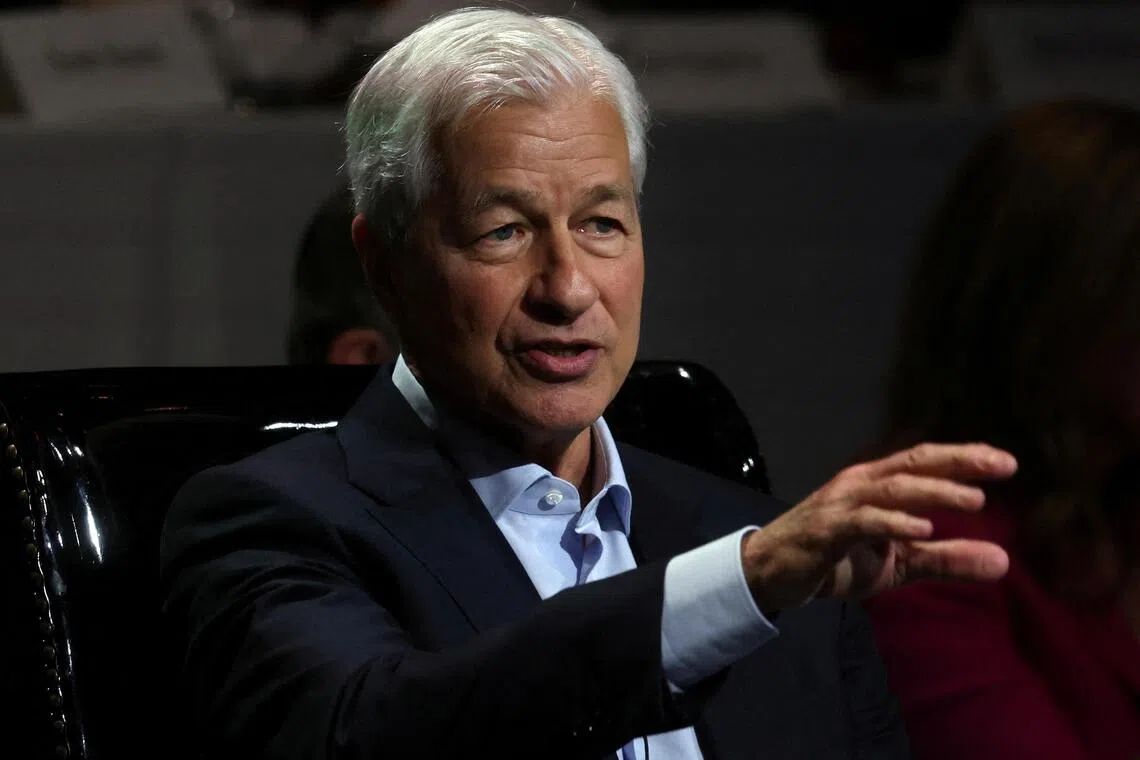‘When you see one cockroach, there are probably more’: Jamie Dimon issues private credit warning
Sign up now: Get ST's newsletters delivered to your inbox

JPMorgan Chase CEO Jamie Dimon said he expects to see more bankruptcies like First Brands' if the private credit market goes into an economic downturn.
PHOTO: REUTERS
Follow topic:
NEW YORK – On Wall Street, everyone is a friendly rival until the losses start. A pair of blow-ups in the private credit market have sparked a war of words over whether banks or private credit firms are better positioned to weather a broader downturn.
Car parts supplier First Brands Group filed for bankruptcy in late September after the company used private credit to run up debts of more than US$10 billion (S$13 billion). Sub-prime car lender Tricolor Holdings did the same in early September amid allegations of car loan fraud.
JPMorgan Chase chief executive Jamie Dimon said he expects to see more bankruptcies like First Brands’ if the private credit market goes into an economic downturn.
“I probably shouldn’t say this, but when you see one cockroach, there are probably more. And so we should – everyone should be forewarned on this one,” he told analysts on his bank’s third-quarter earnings call on Oct 14.
Blue Owl Capital boss Marc Lipschultz fired back, saying the issue was in loans that banks led, so Mr Dimon should be scouring his own books if he wants to squash more bugs.
Mr Lipschultz’s remarks gave voice to the sentiments of a swathe of private credit executives. They have privately complained sloppy diligence from banks on Tricolor and First Brands is instead being held up as evidence of growing risks enabled by private credit lending.
The bickering underscores what is at stake as a tidal wave of change sweeps across the financing landscape. Banks are being forced to cede ground or learn to live alongside upstart lenders, whether they like it or not.
It risks disrupting a delicate detente that has existed over the past few years. Rapidly growing private credit firms have taken some business from banks’ leveraged loan desks, but they have also become some of the banks’ biggest clients and occasional partners.
The clash comes at a time when “there are landmines starting to go off everywhere,” according to Mr Akshay Shah, who runs distressed-debt firm Kyma Capital.
“Marc is saying it’s in the banking corner, and Jamie might say it’s elsewhere,” he said. “I would say it’s going off in both corners.”
And there are plenty of distressed players out there who can sift through the private credit blow-ups or the syndicated loan blow-ups, according to Mr Shah.
“Where Jamie is more right is, in public markets, those cracks are harder to paper over,” he said.
While many non-bank lenders are sophisticated firms that JPMorgan itself helps finance, it is a big category and not every player is “very smart”, Mr Dimon said on Oct 14.
“We don’t know everyone’s underwriting standards,” he said.
“Every now and then, we see what someone else is doing, and we’re surprised at their standards; they’re not particularly good, but that’s always been true. I suspect when there’s a downturn, you will see higher-than-normal downturn type of credit losses in certain categories. I just suspect that.”
Mr Dimon’s comments followed the bank’s disclosure of a US$170 million loss tied to its Tricolor exposure that drove higher-than-expected credit costs in the third quarter.
“The notion of never letting the facts get in the way of a good story may have gone a bit too far here,” said Mr John Cortese, who runs portfolio management and trading at Apollo Global Management.
“These businesses were clearly funded by banks and the public markets. But, ultimately, we view this as late-cycle behaviour where market participants got away from the fundamentals, not as something that is pervasive.”
Mr Dimon also seized on a technical dynamic that has animated credit investors and attracted bets against such vehicles by sophisticated hedge funds.
In particular, many of the biggest private credit business development companies (BDCs) are trading at a notable discount to their net asset value, indicating that shareholders do not believe they will be able to recoup their investment in full if they pull money.
Other signals of stress are flashing, too, with the percentage of payment-in-kind in BDC portfolios – a tool to defer paying cash interest – continuing to rise.
Shares of Blue Owl have tumbled 27 per cent in 2025, and its BDCs have languished.
Blue Owl’s BDCs count about 14 per cent of their investments as payment-in-kind, meaning that some or all of the interest is being deferred until maturity.
“We are mispriced from a sector perspective,” Blue Owl executive Jonathan Lamm said last week.
“The only reason that the sector should be trading off like this is if there is a massive amount of credit defaults coming, which we see no evidence of.” BLOOMBERG

